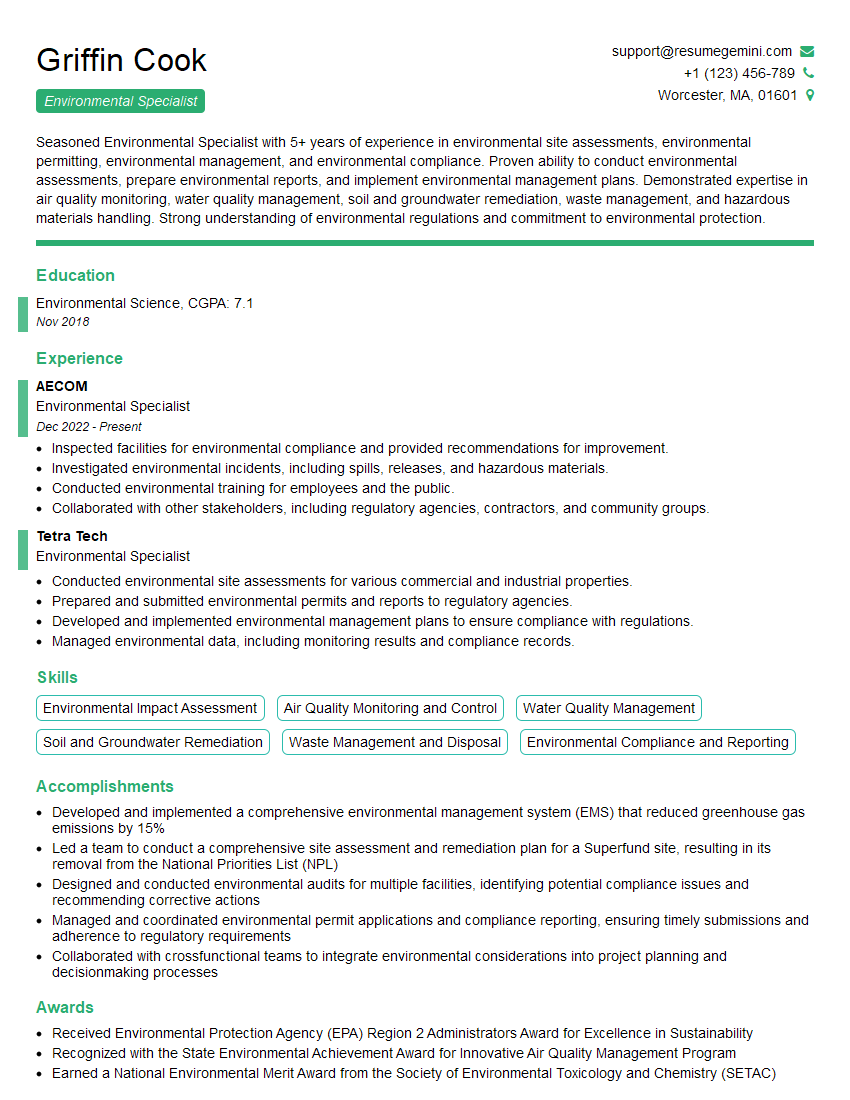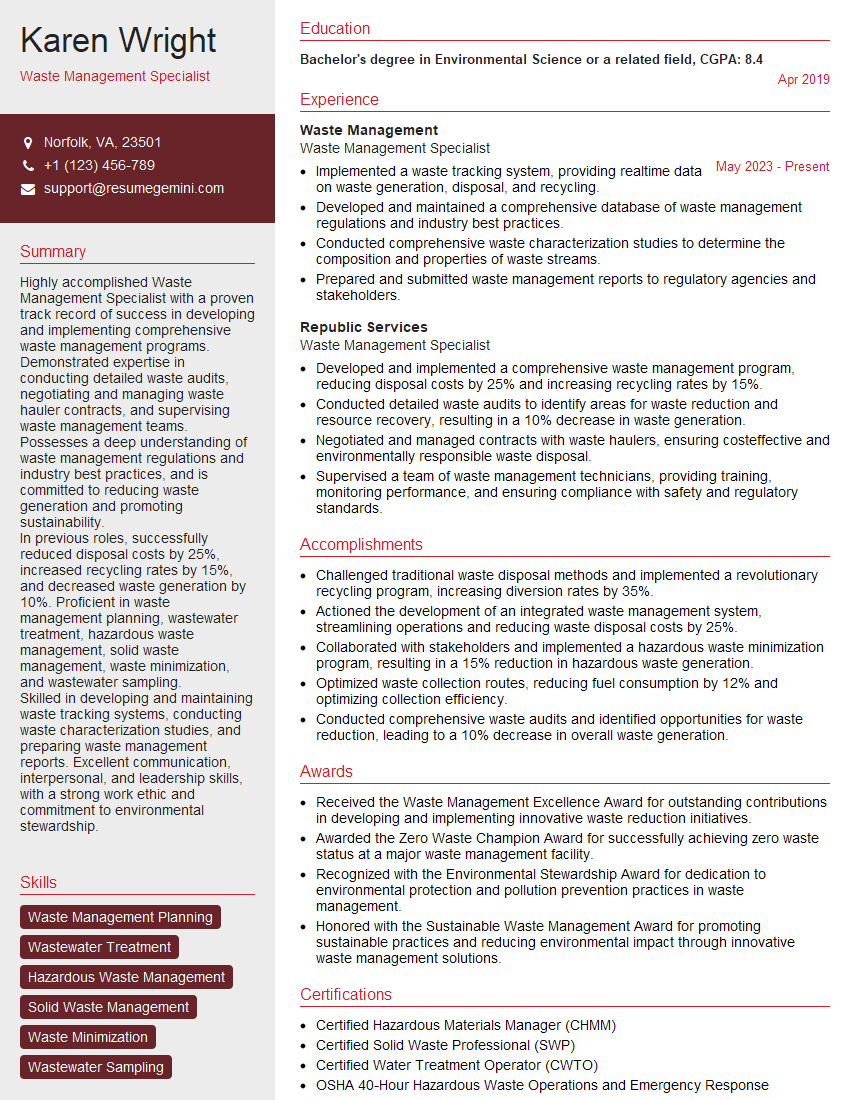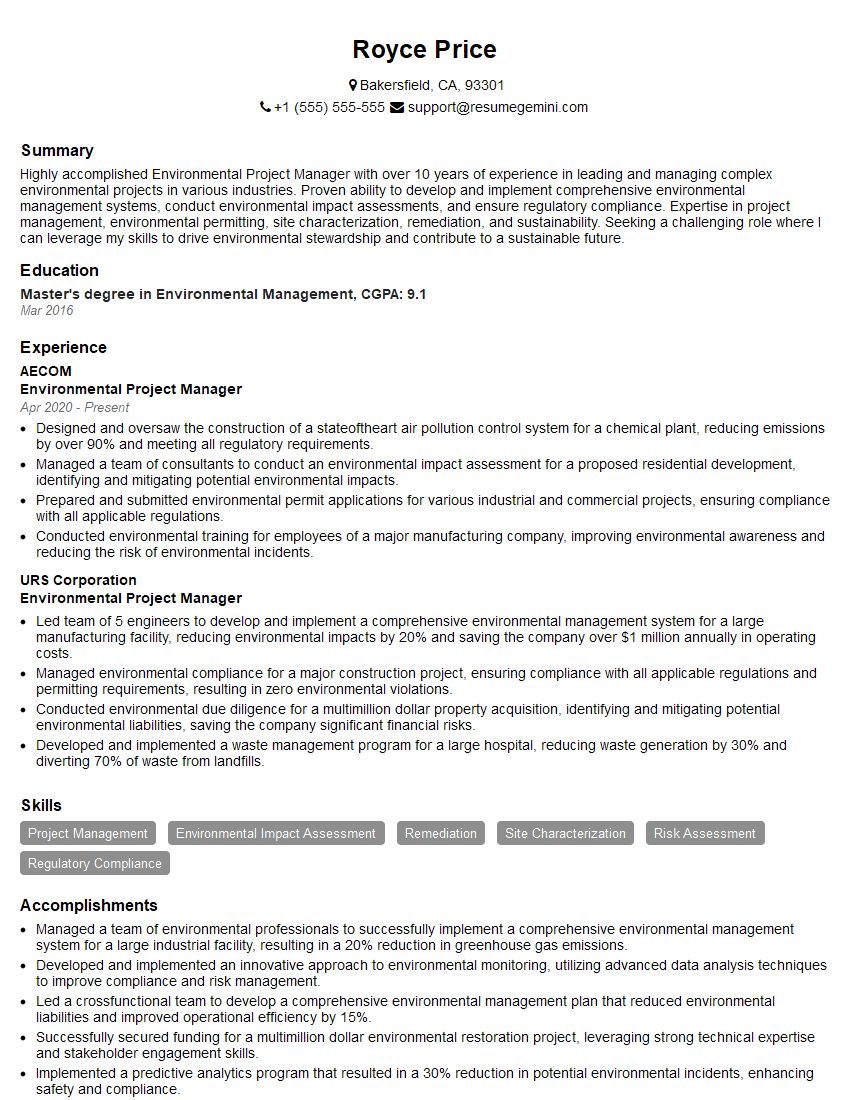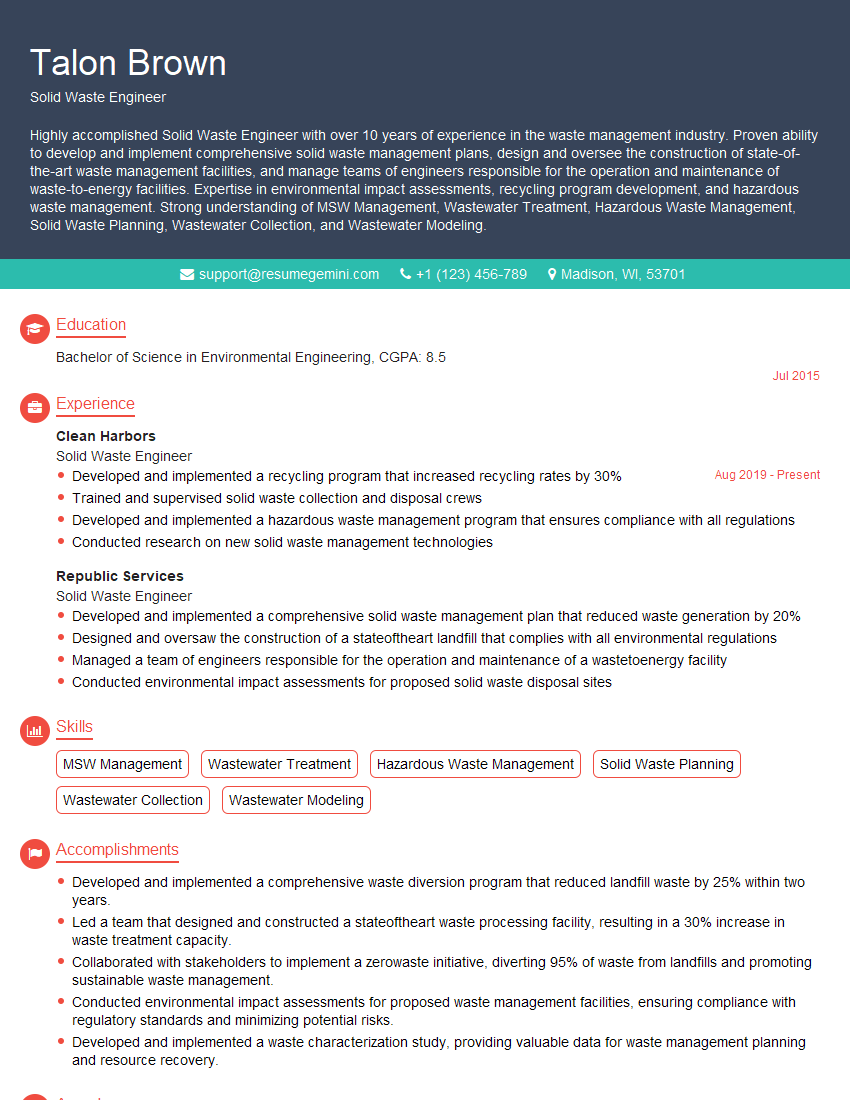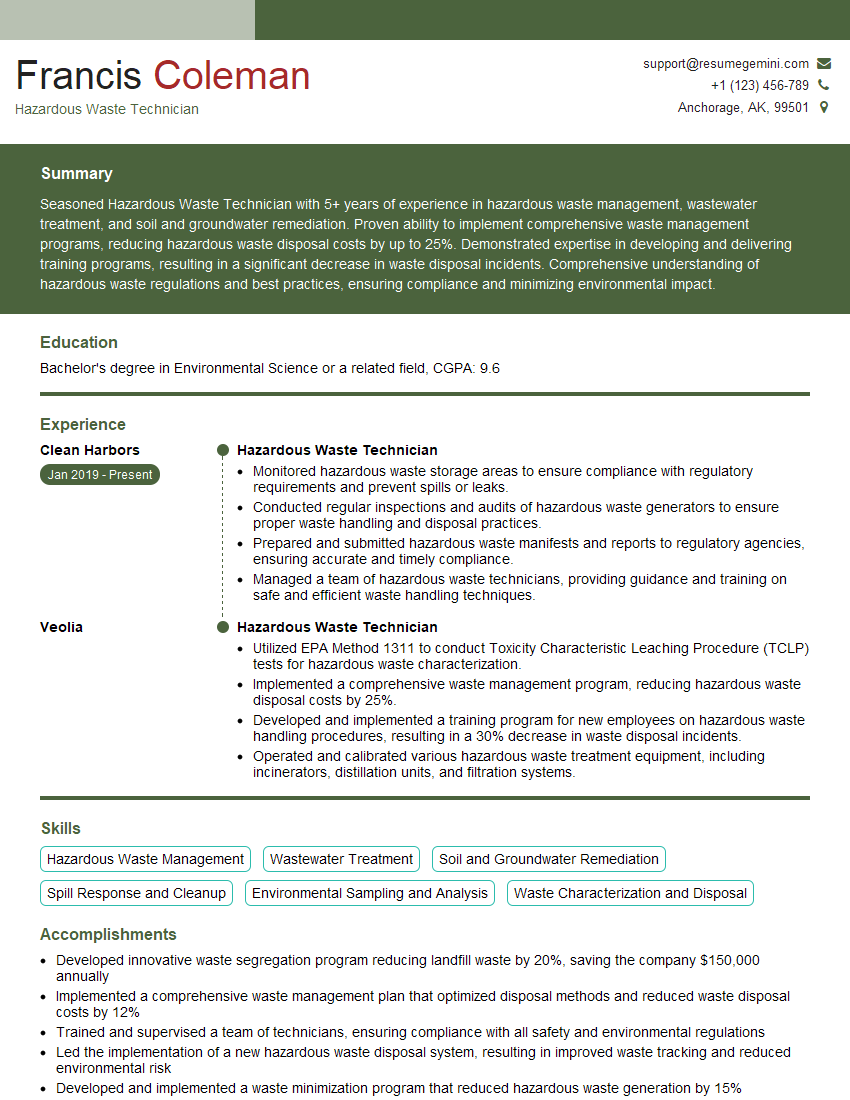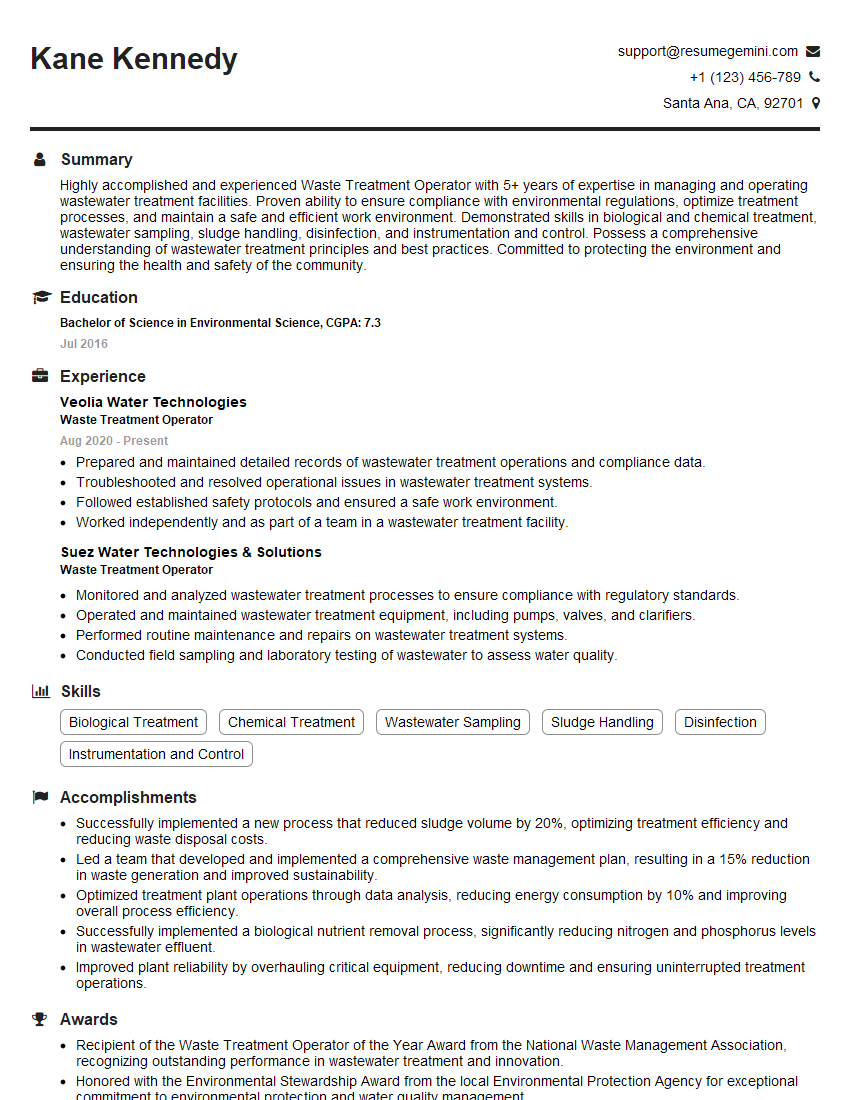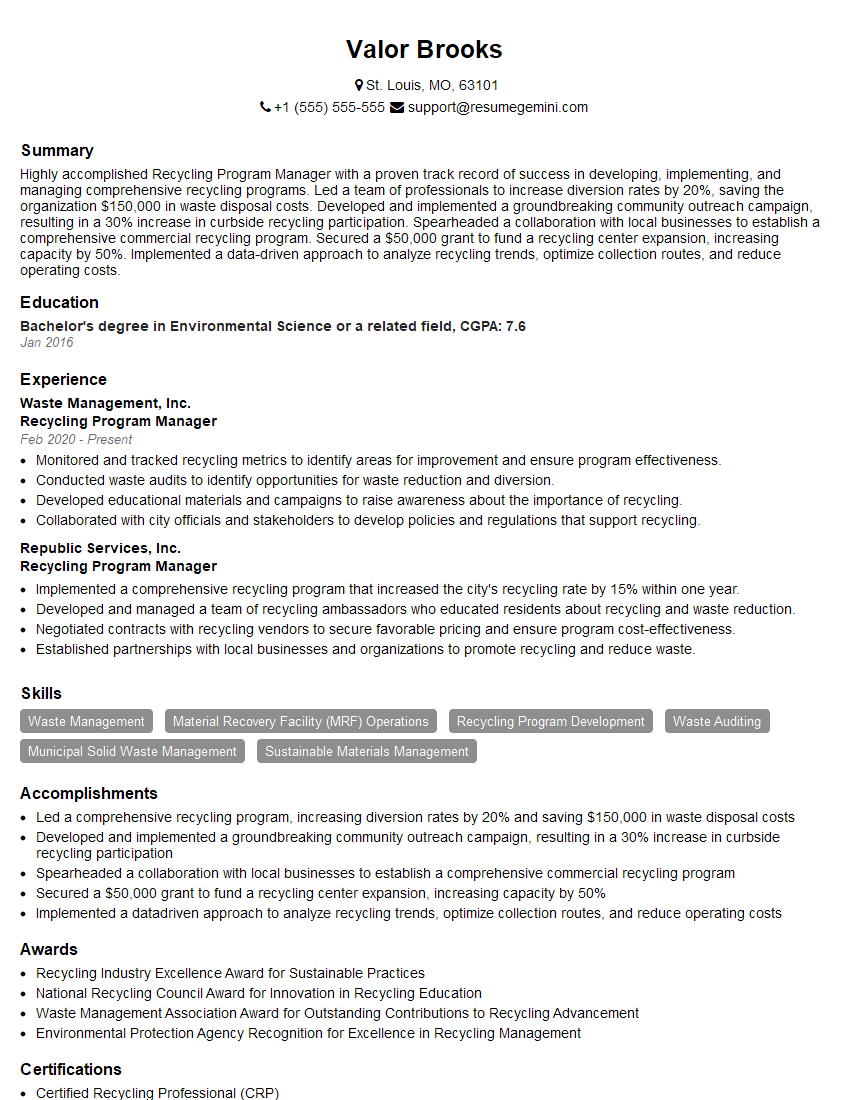Every successful interview starts with knowing what to expect. In this blog, we’ll take you through the top Knowledge of waste disposal regulations and procedures interview questions, breaking them down with expert tips to help you deliver impactful answers. Step into your next interview fully prepared and ready to succeed.
Questions Asked in Knowledge of waste disposal regulations and procedures Interview
Q 1. Explain the difference between hazardous and non-hazardous waste.
The key difference between hazardous and non-hazardous waste lies in its potential to cause harm to human health or the environment. Non-hazardous waste, like household garbage or yard waste, poses minimal risk when properly managed. Hazardous waste, however, exhibits characteristics that make it dangerous. This can include ignitability (easily catches fire), corrosivity (able to corrode metal), reactivity (unstable and readily reacts), or toxicity (poisonous or harmful).
Examples: Non-hazardous waste includes things like food scraps, paper, and plastic bottles. Hazardous waste examples include used motor oil, batteries, pesticides, and medical waste. Improper disposal of hazardous waste can lead to soil and water contamination, air pollution, and serious health issues.
Q 2. Describe the process of obtaining a waste disposal permit.
Obtaining a waste disposal permit is a crucial step for businesses and individuals generating significant amounts of waste, especially hazardous waste. The process varies depending on location and the type of waste, but generally involves these steps:
- Application: Complete a detailed application form provided by the relevant environmental agency (often at the state or local level). This includes information about your business, the type and quantity of waste generated, and your proposed disposal methods.
- Site Inspection: Inspectors will visit your facility to assess your waste handling practices, storage areas, and compliance with safety regulations.
- Permit Review: The agency reviews your application and inspection report to ensure you meet all the necessary criteria. This can take several weeks or months.
- Permit Issuance (or Denial): If approved, you receive a permit specifying the allowed waste types, quantities, disposal methods, and reporting requirements. Failure to comply can result in penalties.
Think of it like getting a driver’s license – you need to demonstrate you understand the rules and can handle the responsibilities before you’re allowed to operate.
Q 3. What are the key components of a waste management plan?
A comprehensive waste management plan is vital for any organization generating waste. Key components include:
- Waste Characterization: Identifying the types and quantities of waste produced.
- Waste Minimization Strategies: Implementing procedures to reduce waste generation through source reduction, reuse, and recycling.
- Waste Segregation and Storage: Establishing clear procedures for separating different waste streams and safely storing them before disposal.
- Waste Transportation: Choosing licensed and insured haulers to transport waste to appropriate facilities.
- Waste Disposal Methods: Specifying the approved methods for each waste type (landfilling, incineration, recycling, etc.).
- Emergency Response Plan: Detailed procedures to address spills, leaks, or other waste-related emergencies.
- Monitoring and Reporting: Regularly tracking waste generation and disposal activities and submitting reports to the regulatory agency as required.
A well-structured plan ensures legal compliance, minimizes environmental impact, and can even lead to cost savings.
Q 4. How do you ensure compliance with EPA regulations regarding waste disposal?
Ensuring EPA (Environmental Protection Agency) compliance is paramount. This involves:
- Staying Informed: Regularly reviewing and understanding updated EPA regulations and guidance documents.
- Proper Record Keeping: Maintaining meticulous records of waste generation, handling, transportation, and disposal. This includes manifests, permits, and other documentation.
- Regular Audits: Conducting internal audits to identify potential compliance gaps and implement corrective actions.
- Employee Training: Ensuring all employees involved in waste handling are properly trained on safe practices and regulatory requirements.
- Third-Party Audits: Undergoing periodic audits by independent environmental consultants to verify compliance.
- Prompt Response to Violations: Addressing any identified violations promptly and implementing corrective measures to prevent recurrence.
Think of it like a regular health check-up for your waste management system; consistent monitoring prevents bigger problems down the line.
Q 5. What are the common methods of waste disposal and their environmental impacts?
Several waste disposal methods exist, each with its environmental impact:
- Landfilling: Burying waste in designated areas. Environmental impacts include leachate (liquid from decomposing waste) contamination of groundwater, greenhouse gas emissions (methane), and land use.
- Incineration: Burning waste at high temperatures. Reduces volume but can produce air pollutants (dioxins, furans) unless equipped with effective pollution control technologies.
- Recycling: Reusing materials to create new products. Reduces landfill burden and conserves resources. However, recycling processes can have energy and water consumption associated with them.
- Composting: Decomposing organic waste to create nutrient-rich soil amendment. Reduces landfill waste and creates a valuable product, but improper composting can lead to odor and pest problems.
The ‘best’ method depends on the type of waste and local environmental conditions. A balanced approach utilizing multiple methods is often preferred.
Q 6. Explain the concept of waste hierarchy and its application.
The waste hierarchy prioritizes waste management options to minimize environmental impact. It follows this order:
- Prevention: Reducing waste generation at the source (e.g., using less packaging).
- Reuse: Using items multiple times before disposal.
- Recycling: Processing materials into new products.
- Recovery: Energy recovery from waste (e.g., incineration with energy capture).
- Disposal: Landfilling or other final disposal methods (least preferred).
Application: A company might implement a policy of reusable containers instead of single-use plastics (prevention and reuse), implement a robust recycling program (recycling), and only landfill unavoidable waste (disposal). Following the hierarchy leads to a more sustainable approach.
Q 7. How do you handle a waste disposal emergency?
Handling a waste disposal emergency, such as a spill or fire, requires swift and decisive action. Your response plan should include:
- Immediate Containment: Prevent further spread of the waste using appropriate barriers (e.g., absorbent materials, berms).
- Notification: Contact emergency services (fire department, environmental agency) and follow established reporting procedures.
- Personnel Safety: Ensure the safety of personnel involved, using appropriate personal protective equipment (PPE).
- Waste Cleanup: Use licensed contractors specializing in hazardous waste cleanup, following all safety guidelines.
- Documentation: Maintain thorough records of the incident, including cleanup methods and waste disposal.
Regular training and drills are crucial to ensure a coordinated and efficient response to any emergency.
Q 8. What are the regulations surrounding the transportation of hazardous waste?
The transportation of hazardous waste is heavily regulated to prevent environmental contamination and protect public health. Regulations vary by jurisdiction but generally involve strict adherence to manifest systems, proper packaging and labeling, vehicle requirements, and driver training. Think of it like shipping a particularly dangerous package – it needs special handling and documentation at every step.
For example, the US Environmental Protection Agency (EPA) mandates the use of a hazardous waste manifest (a detailed tracking document) that accompanies the waste from its point of generation to its final disposal facility. This manifest details the type and quantity of waste, the generator’s and transporter’s information, and the destination facility. Improperly filled manifests or failure to follow the chain of custody can result in significant penalties.
Further, transporters must possess the necessary permits and licenses, ensure their vehicles meet specific safety standards (e.g., leak-proof containers, secure fastening mechanisms), and adhere to transportation routes to minimize the risk of spills or accidents. Driver training often includes specialized courses on handling hazardous materials and emergency response procedures.
Q 9. Describe your experience with waste audits and compliance reporting.
I have extensive experience conducting waste audits and preparing compliance reports. This involves reviewing a facility’s waste generation, storage, handling, and disposal practices to identify areas of non-compliance with relevant regulations. Think of it as a thorough health check for a company’s waste management system.
My approach includes a detailed on-site assessment, analyzing waste streams, reviewing documentation (manifests, permits, training records), interviewing personnel, and sampling waste where necessary. Following the audit, I prepare a comprehensive report detailing findings, including areas of compliance and non-compliance, with prioritized recommendations for corrective actions.
For example, during an audit at a manufacturing facility, I identified discrepancies between reported waste generation quantities and the actual waste volume observed. This discrepancy triggered a deeper investigation revealing an undocumented disposal practice, which was rectified through improved record-keeping and staff training. The final report clearly laid out these findings, the corrective measures implemented, and a schedule for future compliance monitoring.
Q 10. How do you ensure proper record-keeping for waste disposal activities?
Proper record-keeping is crucial for demonstrating compliance with waste disposal regulations. Think of it as keeping a detailed diary of every step of the waste management process. This involves maintaining comprehensive documentation for every aspect of waste handling, from generation to final disposal.
This typically includes waste manifests, permits, training records for personnel, waste characterization data, storage records, and disposal records. All records must be accurate, complete, readily accessible, and maintained for the required retention period (which varies by regulation and waste type). I use a combination of digital and physical record-keeping systems, ensuring data integrity and easy retrieval.
For instance, I employ a database system to track waste generation, disposal methods, and associated costs. This allows for efficient reporting, trend analysis, and identification of opportunities for waste reduction and optimization. Furthermore, a robust filing system for physical documents, organized by date and waste type, ensures easy access during audits or inspections.
Q 11. Explain your understanding of different waste treatment technologies.
My understanding of waste treatment technologies is broad and encompasses various methods for treating different waste streams. These technologies aim to reduce the volume and hazard of waste, preparing it for safe disposal or recovery.
- Incineration: High-temperature burning to reduce waste volume and recover energy. However, air emissions require stringent control.
- Landfilling: A common, but often controversial, method for disposing of solid waste. Modern landfills incorporate liners and leachate collection systems to minimize environmental impact.
- Biological Treatment: Using microorganisms to break down organic waste, producing compost or biogas. Examples include anaerobic digestion and composting.
- Chemical Treatment: Neutralization, precipitation, and other chemical processes to render hazardous waste less harmful.
- Physical Treatment: Methods such as screening, shredding, and separation to process waste for recycling or disposal.
Choosing the appropriate technology depends on factors such as waste characteristics, cost, regulatory requirements, and environmental impact considerations. For example, a facility generating large quantities of organic waste might opt for anaerobic digestion to produce biogas, a renewable energy source, while a hazardous waste generator might utilize chemical treatment to stabilize the waste before landfilling.
Q 12. How do you identify and manage potential environmental risks associated with waste disposal?
Identifying and managing environmental risks associated with waste disposal is paramount. This involves a proactive approach to risk assessment, implementation of control measures, and emergency preparedness. Think of it as preventative medicine for the environment.
My risk assessment process starts with characterizing the waste, identifying potential pathways of release (e.g., spills, leachate migration, air emissions), and evaluating the potential consequences of these releases (e.g., soil and groundwater contamination, air pollution). Based on the assessment, control measures are implemented, such as proper containment, leak detection systems, and emergency response plans.
For example, a landfill site requires a detailed assessment of groundwater flow patterns to prevent leachate contamination. Mitigation measures might include installing impermeable liners, monitoring wells, and leachate collection and treatment systems. In case of an accidental release, a well-defined emergency response plan, including spill response procedures and communication protocols, is crucial to minimize environmental damage and protect human health.
Q 13. What is your experience with waste reduction and recycling programs?
I’ve been involved in developing and implementing various waste reduction and recycling programs, aiming to minimize waste generation and maximize resource recovery. Think of it as closing the loop in the materials cycle.
My approach typically involves conducting a waste audit to identify opportunities for waste reduction, promoting source reduction techniques (e.g., reducing packaging, using reusable materials), and establishing recycling programs. This often includes educating employees and stakeholders on proper waste sorting, handling, and recycling procedures.
For instance, at a previous organization, we implemented a comprehensive recycling program, separating paper, plastics, metals, and other recyclables. This resulted in a significant reduction in landfill waste, cost savings on disposal fees, and a positive impact on the company’s environmental footprint. Furthermore, we conducted workshops to train staff on waste reduction techniques, leading to a change in behavior and further reducing waste generation at the source.
Q 14. Describe your knowledge of relevant legislation (e.g., RCRA, CERCLA).
My knowledge of relevant legislation is extensive and includes a thorough understanding of key statutes such as the Resource Conservation and Recovery Act (RCRA) and the Comprehensive Environmental Response, Compensation, and Liability Act (CERCLA), also known as Superfund.
RCRA regulates the generation, transportation, treatment, storage, and disposal of hazardous waste. It establishes a cradle-to-grave tracking system, requiring generators to identify hazardous waste, obtain permits, and manage their waste in compliance with stringent requirements. Understanding RCRA is essential for anyone working with hazardous materials.
CERCLA addresses the cleanup of uncontrolled hazardous waste sites. It establishes a liability framework, holding responsible parties accountable for the remediation of contaminated sites. Knowledge of CERCLA is vital for understanding the complexities of hazardous waste remediation and associated liabilities. Furthermore, I’m familiar with state-level regulations, which often mirror or augment federal statutes.
Q 15. How do you stay updated on changes in waste disposal regulations?
Staying current with waste disposal regulations requires a multi-pronged approach. It’s not a one-time task, but an ongoing commitment. I subscribe to industry-specific newsletters and journals like Waste Management World and Resource Recycling. These publications often highlight regulatory changes and best practices. I also actively participate in professional organizations like the Solid Waste Association of North America (SWANA), attending webinars and conferences. These events offer invaluable networking opportunities and direct access to regulatory updates. Finally, I regularly check the websites of relevant government agencies, such as the Environmental Protection Agency (EPA) at the federal level and equivalent state agencies, for official updates and changes to regulations.
For example, recently, I noticed a change in the EPA’s guidelines concerning the disposal of certain types of electronic waste through participation in a SWANA webinar. This allowed me to immediately update our company’s procedures, ensuring we remained compliant.
Career Expert Tips:
- Ace those interviews! Prepare effectively by reviewing the Top 50 Most Common Interview Questions on ResumeGemini.
- Navigate your job search with confidence! Explore a wide range of Career Tips on ResumeGemini. Learn about common challenges and recommendations to overcome them.
- Craft the perfect resume! Master the Art of Resume Writing with ResumeGemini’s guide. Showcase your unique qualifications and achievements effectively.
- Don’t miss out on holiday savings! Build your dream resume with ResumeGemini’s ATS optimized templates.
Q 16. Explain the role of a manifest in hazardous waste transportation.
A manifest is essentially a detailed accounting document that tracks hazardous waste from the moment it’s generated to its final disposal. Think of it as a passport for hazardous waste. It ensures the responsible transportation and disposal of hazardous materials by providing a clear chain of custody. Each transfer of hazardous waste requires a new manifest entry. The manifest includes critical information such as the generator’s and transporter’s names and addresses, the quantity and type of waste, the destination facility, and the date of transfer. It’s a legally binding document, crucial for compliance and accountability. Without a properly completed manifest, transporters and disposal facilities risk hefty fines and legal repercussions.
For instance, if a company is transporting PCB-contaminated materials, the manifest needs to clearly specify the type of PCB waste, its weight, the transporter’s identification, and the permitted disposal facility that’s equipped to handle it. Any discrepancy or missing information would lead to significant problems.
Q 17. Describe your understanding of landfill management practices.
Landfill management encompasses a complex set of engineering and operational practices designed to minimize environmental impact and ensure public safety. It starts with site selection – choosing locations that meet stringent geological and hydrological requirements to prevent groundwater contamination. The landfill itself comprises multiple layers, including a liner system (typically clay and geomembrane) to contain leachate, a drainage system to collect this leachate, and a final cover to prevent infiltration of rainwater. Waste is compacted and regularly covered with soil to minimize odor and pest attraction. Regular monitoring of groundwater and gas is vital to detect and address any potential environmental issues. This process is crucial in minimizing the environmental and public health impacts of waste disposal.
In my experience, I’ve seen firsthand the importance of proper gas management in landfills. Methane, a potent greenhouse gas, is a byproduct of decomposition. Landfills often employ gas collection systems to capture this methane, which can then be used as an energy source or flared to prevent its release into the atmosphere, reducing the environmental footprint.
Q 18. What is your experience with leachate management?
Leachate, the liquid that percolates through waste in a landfill, can contain various contaminants and pose a significant environmental threat. Effective leachate management is critical for protecting groundwater and surface water resources. This includes designing and maintaining proper leachate collection and treatment systems. These systems often involve a combination of physical, chemical, and biological treatment processes to remove pollutants before the treated leachate is discharged or further processed. Regular monitoring of leachate quality is also essential to track treatment effectiveness and identify any emerging problems. The treated leachate should comply with the standards established by relevant environmental regulations.
During my work at a large municipal landfill, we faced challenges with exceeding permitted levels of specific contaminants in the leachate. We addressed this by implementing an advanced treatment system that included activated carbon filtration and reverse osmosis, leading to a significant improvement in leachate quality and regulatory compliance.
Q 19. How do you ensure the safe handling and disposal of medical waste?
Safe handling and disposal of medical waste is paramount due to the potential for infection and contamination. This involves adherence to strict protocols that encompass segregation at the point of generation, using appropriate containers for different waste streams (sharps, infectious waste, etc.), and appropriate treatment, such as autoclaving or incineration, before final disposal. Color-coded bags and containers help with segregation. Transportation of medical waste necessitates specialized vehicles and trained personnel to prevent leaks and spills. Disposal facilities must have the necessary permits and infrastructure to handle medical waste safely and responsibly. Strict record-keeping is essential to maintain traceability and accountability.
In one project, I helped a small clinic implement a comprehensive medical waste management plan, including training staff on proper waste segregation and handling procedures. This ensured consistent compliance with relevant regulations and reduced the risk of infection and environmental contamination.
Q 20. What are the best practices for preventing waste generation?
Preventing waste generation is far more efficient and environmentally sound than dealing with it after it’s produced. This involves a multifaceted approach – the three Rs: Reduce, Reuse, Recycle. Reducing waste begins with thoughtful design and purchasing decisions, selecting products with minimal packaging and longer lifespans. Reusing items extends their lifespan, preventing premature disposal. Recycling diverts materials from landfills and conserves resources. Beyond the 3Rs, implementing composting programs for organic waste, developing efficient waste reduction strategies within organizations, and public education campaigns on waste minimization practices are all effective measures.
For example, our company implemented a comprehensive recycling program including a detailed composting strategy for our cafeteria waste, which resulted in a 30% reduction in landfill waste within the first year.
Q 21. Describe your experience with environmental impact assessments related to waste disposal.
Environmental Impact Assessments (EIAs) are crucial for evaluating the potential environmental consequences of waste disposal projects. My experience involves conducting and reviewing EIAs for various projects, from small-scale waste transfer stations to large-scale landfills. These assessments examine potential impacts on air and water quality, soil contamination, greenhouse gas emissions, biodiversity, and noise pollution. We use various tools and methodologies, including modeling and risk assessments, to predict and quantify these impacts. The EIA process typically includes stakeholder consultation and public participation to ensure a transparent and inclusive evaluation. The findings of the EIA inform decisions about project design, mitigation measures, and ultimately whether the project proceeds.
I participated in the EIA for a proposed landfill expansion. Our assessment revealed potential impacts on a nearby wetland. As a result, we developed a mitigation plan including wetland restoration measures, which was incorporated into the final project design and approved by regulatory agencies.
Q 22. How do you manage waste disposal costs effectively?
Effective waste disposal cost management requires a multi-pronged approach focusing on waste reduction, efficient sorting and processing, and smart procurement. It’s not just about finding the cheapest disposal option, but the most cost-effective overall solution.
- Waste Reduction: Implementing a robust waste audit to identify areas of excess waste generation is crucial. This might reveal opportunities for process optimization, product redesign, or employee training programs to reduce unnecessary waste at the source. For example, in a manufacturing setting, switching to bulk packaging instead of individual units can drastically reduce packaging waste and associated disposal costs.
- Improved Sorting and Processing: Efficiently separating recyclable materials from non-recyclable waste allows for maximizing revenue from recyclables and minimizing disposal fees for the remaining waste stream. Investing in better sorting equipment or training staff on proper waste segregation can yield significant savings. For instance, implementing a color-coded waste bin system with clear labels significantly improves sorting accuracy.
- Strategic Procurement: Choosing vendors with competitive pricing and transparent waste management practices is vital. Requesting quotes from multiple waste disposal companies, negotiating contracts, and considering alternative disposal methods such as composting or anaerobic digestion can significantly reduce overall costs.
- Data-Driven Decision Making: Regularly tracking waste generation and disposal costs allows for identifying trends and making informed decisions regarding waste management strategies. This data can inform adjustments to processes and contract negotiations to further optimize costs.
For instance, in a previous role, by implementing a comprehensive waste audit and negotiating a new contract with a waste management company offering competitive pricing for recyclable materials, we managed to reduce annual waste disposal costs by 15%.
Q 23. What are your strategies for communicating waste management policies to employees?
Communicating waste management policies effectively requires a multi-channel approach tailored to the specific needs of the workforce. It’s about making the information clear, accessible, and engaging.
- Training Sessions: Conducting interactive training sessions, workshops, or online modules ensures all employees understand the company’s waste management policies, procedures, and best practices. These sessions should include hands-on demonstrations and opportunities for Q&A.
- Visual Aids: Utilizing clear and concise signage, posters, and infographics in common areas facilitates easy access to key information. Color-coded waste bins with clear labels reduce confusion and improve compliance.
- Regular Communication: Regular updates through emails, newsletters, or internal communication platforms keep employees informed of changes to policies, new initiatives, and company progress towards waste reduction goals. Highlighting employee successes and contributions can foster a sense of collective responsibility.
- Incentive Programs: Implementing reward systems, such as employee recognition programs or friendly competitions, can further motivate employees to actively participate in the waste management program and promote a culture of sustainability.
- Feedback Mechanisms: Creating opportunities for employees to provide feedback through surveys, suggestion boxes, or regular meetings allows for addressing concerns and improving the program’s effectiveness.
In my previous experience, we saw a marked improvement in waste segregation compliance after introducing a gamified recycling program that rewarded teams with the highest recycling rates with small prizes, generating friendly competition and a more engaged workforce.
Q 24. Explain your experience with working with different regulatory agencies.
My experience working with regulatory agencies has been extensive, encompassing interactions with both local and national environmental protection bodies. This involves ensuring full compliance with relevant regulations and permits, including waste characterization, transportation, and disposal procedures.
- Permitting and Compliance: I have successfully navigated the process of obtaining and maintaining all necessary permits and licenses for waste handling and disposal operations. This involves submitting accurate and timely reports, undergoing regular inspections, and maintaining detailed records.
- Regulatory Audits: I possess experience in preparing for and managing regulatory audits, proactively addressing any identified non-compliances, and implementing corrective actions to ensure ongoing compliance. This includes conducting internal audits to identify potential issues before they are discovered by external agencies.
- Stakeholder Management: Effective communication and collaboration with regulatory agencies is key. This requires maintaining open lines of communication, providing timely responses to requests, and addressing concerns promptly and professionally.
- Staying Updated: The regulatory landscape is constantly evolving, requiring proactive monitoring of legislative changes and updates to ensure continuous compliance. This includes participation in industry events and utilizing subscription services for regulatory updates.
For example, I successfully guided a company through a major regulatory audit by the EPA, resulting in a clean bill of health, highlighting our commitment to environmental compliance and efficient record-keeping.
Q 25. Describe a time you had to troubleshoot a problem related to waste disposal.
One time, we experienced a significant blockage in our facility’s main waste disposal pipeline. This resulted in a temporary halt in waste processing and posed a considerable operational and environmental risk.
- Problem Identification: The initial issue was identified by a sharp decline in waste processing rates, accompanied by unusual back-pressure in the pipeline system.
- Investigation: A thorough investigation was carried out using CCTV cameras to inspect the pipeline, revealing a significant buildup of non-degradable waste, including plastics and rags, which caused the blockage.
- Solution Implementation: We immediately implemented a two-pronged approach: (a) A specialized high-pressure jetting system was employed to clear the pipeline, and (b) an emergency waste diversion plan was activated to manage waste until the pipeline was fully operational again.
- Root Cause Analysis: Following the incident, a thorough root cause analysis was performed, revealing inadequate employee training on proper waste segregation and disposal practices.
- Corrective Actions: We enhanced employee training programs by including practical demonstrations and implementing a stricter waste segregation system, including additional signage and clear waste disposal guidelines.
This experience underscored the importance of proactive maintenance, rigorous employee training, and robust contingency planning for waste disposal systems.
Q 26. How do you ensure the safety of employees involved in waste handling procedures?
Ensuring employee safety during waste handling procedures is paramount. It requires a comprehensive approach encompassing training, personal protective equipment (PPE), and adherence to strict safety protocols.
- Comprehensive Training: Employees involved in waste handling must undergo thorough training on safe handling techniques, hazard identification, and the proper use of PPE. This includes training on specific hazards associated with different types of waste, such as chemical waste or infectious materials.
- Personal Protective Equipment (PPE): Providing appropriate PPE, such as gloves, safety glasses, respirators, and protective clothing, is essential to mitigate risks. The selection of PPE should be based on a thorough hazard assessment specific to the waste being handled.
- Safe Work Practices: Establishing and enforcing strict safe work practices, including proper lifting techniques, use of mechanical aids for heavy waste, and avoidance of unsafe practices such as mixing incompatible materials, is crucial. Regular safety inspections of equipment and work areas are necessary.
- Emergency Procedures: Develop and regularly practice emergency response plans, including spill response procedures and procedures for dealing with injuries. This will improve the response time and effectiveness in case of any incidents. Employees need to be familiar with emergency contacts and reporting procedures.
- Regular Monitoring and Evaluation: Regular monitoring and evaluation of the safety program, including incident reporting and analysis, help identify areas for improvement and prevent future accidents. This includes reviewing safety performance indicators and conducting regular safety audits.
For example, we implemented a buddy system for waste handling, requiring all employees to work in pairs, ensuring constant supervision and minimizing the risk of accidents during waste handling operations.
Q 27. What are your experience and understanding of different types of recycling processes?
My understanding of recycling processes is extensive, encompassing various methods for different types of materials. This includes both mechanical and chemical recycling approaches.
- Mechanical Recycling: This involves physically processing materials to recover reusable materials. For plastics, this can involve processes such as shredding, washing, and melting to create new plastic products. Paper recycling involves pulping and reprocessing paper fibers. Metals often undergo processes like shredding, separation, and smelting.
- Chemical Recycling: This involves breaking down materials at a molecular level to recover their constituent components. This approach is useful for plastics that are difficult to recycle mechanically, or to recover valuable chemicals. Examples include pyrolysis (breaking down polymers using heat) and depolymerization.
- Composting: Organic waste, such as food scraps and yard waste, can be composted, creating nutrient-rich soil amendment. This is a biological process that utilizes microorganisms to decompose organic matter.
- Anaerobic Digestion: This process breaks down organic waste in the absence of oxygen, producing biogas (a renewable energy source) and digestate (a fertilizer). It’s particularly beneficial for processing large volumes of organic waste.
In a previous project, I oversaw the implementation of a new recycling system for a manufacturing plant, incorporating both mechanical and chemical recycling methods to maximize the recovery rate of different plastic types, resulting in a significant reduction in landfill waste and an increase in revenue generation from recovered materials.
Key Topics to Learn for Knowledge of Waste Disposal Regulations and Procedures Interview
- Hazardous Waste Management: Understanding the classification, handling, storage, transportation, and disposal of hazardous waste according to relevant regulations (e.g., RCRA in the US). Practical application includes analyzing waste streams to determine proper disposal methods and ensuring compliance with permits and reporting requirements.
- Waste Reduction and Recycling Programs: Knowledge of different waste reduction strategies (source reduction, reuse, recycling) and the implementation of effective recycling programs. Practical application includes developing and implementing a waste reduction plan for a facility, monitoring recycling rates, and identifying areas for improvement.
- Wastewater Treatment and Disposal: Understanding wastewater treatment processes, effluent discharge permits, and regulations concerning the discharge of wastewater into the environment. Practical application involves troubleshooting issues in a wastewater treatment plant and ensuring compliance with environmental regulations.
- Solid Waste Management: Knowledge of different methods of solid waste disposal (landfills, incineration, composting) and the environmental impacts of each method. Practical application involves designing and managing solid waste collection and disposal systems while minimizing environmental impacts.
- Environmental Regulations and Compliance: Familiarity with relevant environmental laws and regulations, including permit applications, reporting requirements, and enforcement procedures. Practical application includes conducting environmental audits and ensuring compliance with all applicable regulations.
- Emergency Response and Spill Prevention: Understanding procedures for handling waste-related emergencies, including spill prevention, containment, and cleanup. Practical application includes developing and implementing emergency response plans and training employees on proper procedures.
- Waste Tracking and Documentation: Proficiency in maintaining accurate records of waste generation, handling, and disposal, ensuring traceability and compliance with regulatory requirements. Practical application involves using waste tracking software and preparing reports for regulatory agencies.
Next Steps
Mastering knowledge of waste disposal regulations and procedures is crucial for advancing your career in environmental management, waste processing, and related fields. Demonstrating this expertise through a strong resume is key to securing your ideal role. Creating an ATS-friendly resume increases your chances of getting noticed by recruiters. ResumeGemini is a trusted resource to help you build a professional and impactful resume that highlights your skills and experience. Examples of resumes tailored to showcasing expertise in Knowledge of waste disposal regulations and procedures are available to guide you through the process.
Explore more articles
Users Rating of Our Blogs
Share Your Experience
We value your feedback! Please rate our content and share your thoughts (optional).
What Readers Say About Our Blog
Live Rent Free!
https://bit.ly/LiveRentFREE
Interesting Article, I liked the depth of knowledge you’ve shared.
Helpful, thanks for sharing.
Hi, I represent a social media marketing agency and liked your blog
Hi, I represent an SEO company that specialises in getting you AI citations and higher rankings on Google. I’d like to offer you a 100% free SEO audit for your website. Would you be interested?


